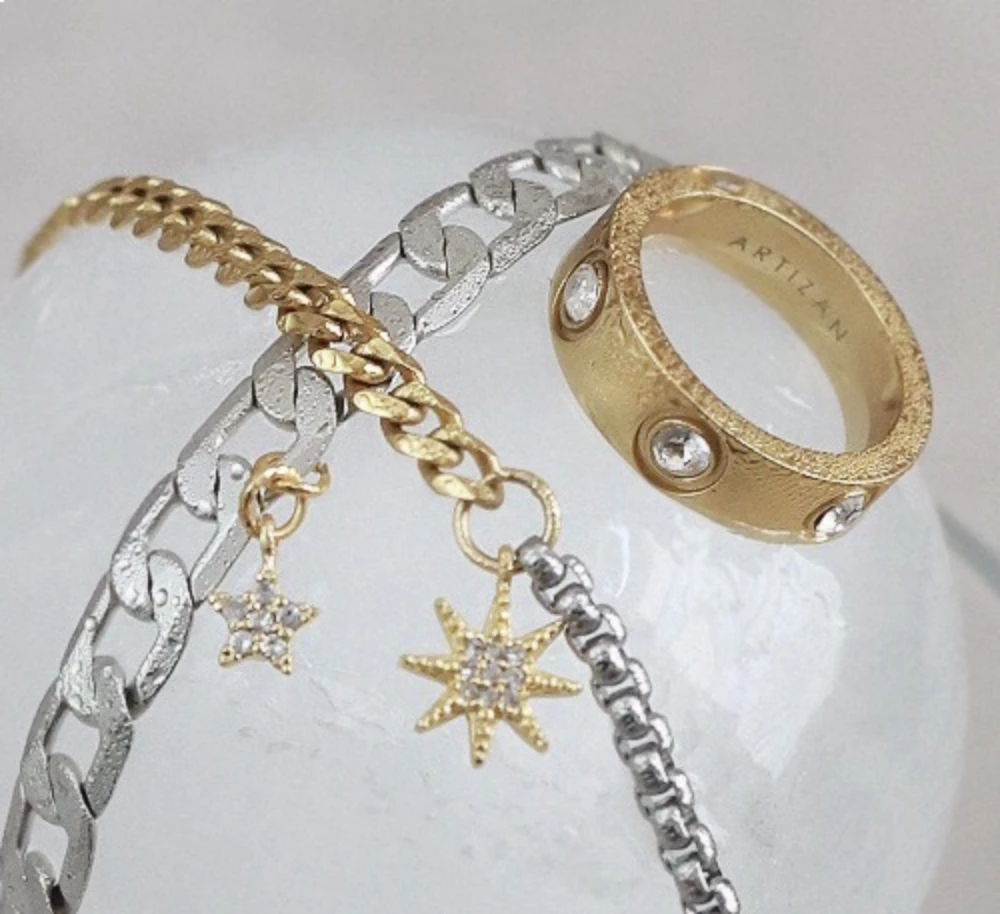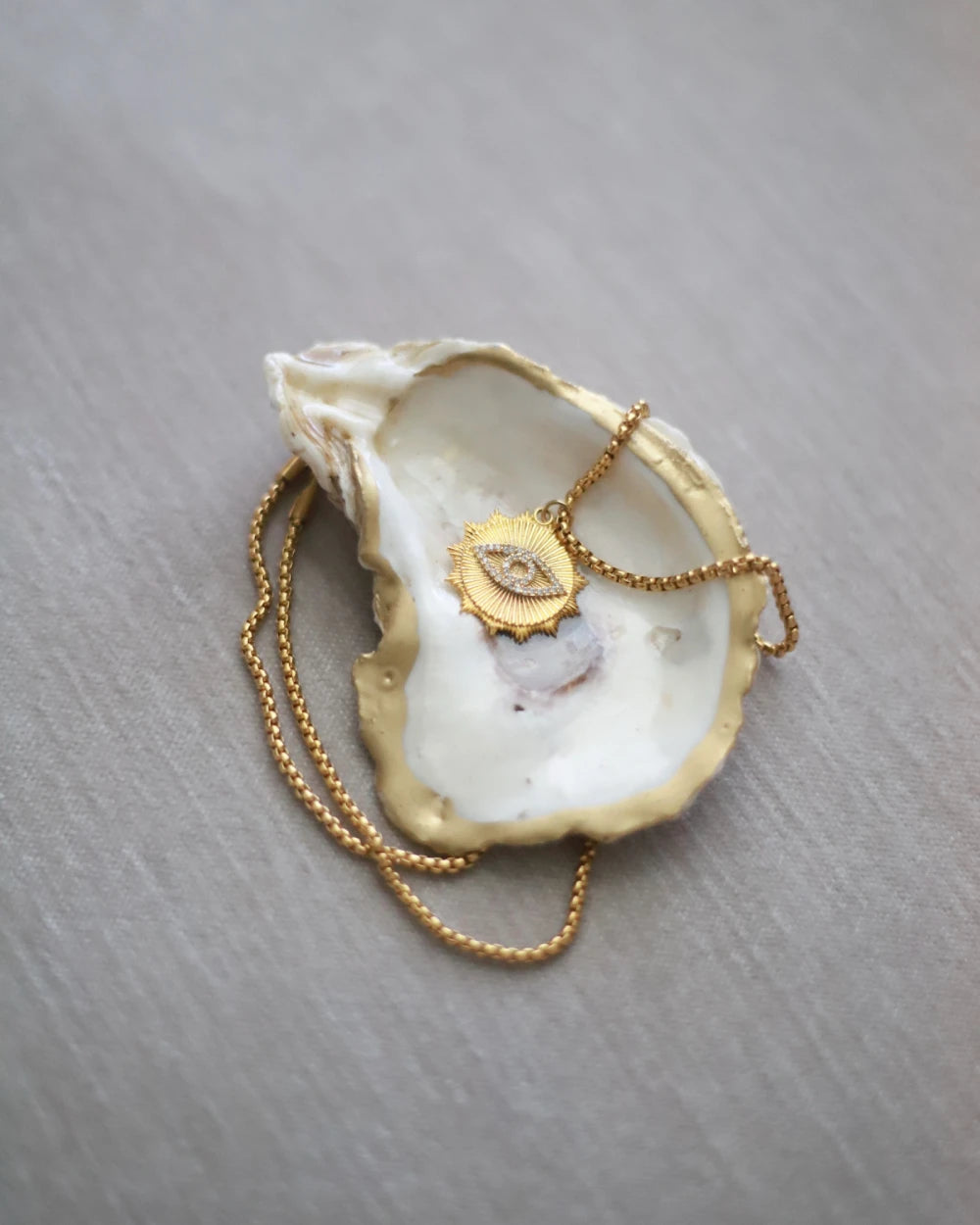Gold-plated Jewelry: What It Is and How To Make It Last Longer
Shop This Story
What Is Gold-plated Jewelry?

Gold-plated jewelry is a type of metal jewelry covered with a very thin layer of real gold.
The process was invented in 1805 by Italian chemist Luigi Brugnatelli who plated a very thin gold layer on top of silver. Since then, it has become commonplace in the jewelry world, with many base metals covered in gold, silver, or rhodium.
The best thing about this process? It mimics the appearance of expensive pieces of jewelry to near perfection, so the difference between the two isn’t noticeable.
The thickness of the gold plating used to make gold-plated jewelry can vary from 0.17 microns, which is called electroplated or wash/flashed gold, and 2.5 microns, the highest thickness available. Platings that tend to wear off quickly are typically used in pendants, earrings, and other pieces that are sheltered from wear and tear, while their thicker counterparts — 0.5 and microns and above — are suitable for use in jewelry pieces like rings, bracelets, and other items that can stand their ground when exposed to rough wear.
How is Gold-plated Jewelry Made?

Making gold-plated jewelry is pretty simple.
- It uses a base metal which can be anything from brass, copper, and nickel to silver, stainless steel, tungsten, and titanium to create a jewelry piece.
- Once it is made, it is cleaned thoroughly via steam cleaning, electro cleaning, or ultrasonic cleaning to rid it of dirt, dust, oil, and other pollutants. This is done to ensure there’s a clean base that won’t prevent the gold layer from bonding to it.
- The jewelry is then rinsed to get rid of any traces of the purifying agent.
- A thin buffer layer of nickel is then plated on the base metal. This keeps it from impacting the gold layer, making it unlikely for your gold-plated jewelry to flake, tarnish, or fade. It also improves the bond between the base metal and the layer of gold.
- To seal the deal, the metal-based jewelry is dipped in the plating solution and a positive electrical charge with controlled temperature and voltage. This is done to attract gold ions onto the base metal to create a thin plating.
- Once the desired plating thickness is achieved, the jewelry is rinsed with water and hung to dry.
To check whether the fashionable piece you’ve brought is gold-plated:
- Check for markings. It should have GP (gold-plated), RGP (rolled gold-plated), or HGP (heavy gold-plated) stamped on it.
- Get an acid test from the jeweler to see if it initiates a color change. This will show how much gold is used in its formulation.
Is Gold-plated Jewelry Valuable?

Gold-plated jewelry contains only a tiny amount of gold, which is what makes it affordable. The thickness of the gold layer can differ across collections and so can the fineness (10K to 24K) of gold used. The purity of gold can affect the price tag and the color it produces but has little effect on its value.
That said, gold pieces typically have a super thin layer of gold, so even if the karat is high, it won’t amount to much overall. It’s also difficult to restore and has a pretty insignificant profit margin for gold refineries so gold-plated jewelry should not be used as an investment or instrument for financial security.
Does Gold-plated Jewelry Fade and Tarnish?

Gold-plated jewelry can fade and tarnish but this doesn’t happen to all of them. Jewelry pieces, like the ones produced by Artizan, have a stainless steel base that prevents it from fading or tarnishing.
This means that you ought to carefully choose where you source your jewelry since many of the pieces available on the market are prone to deterioration. Despite the belief that gold-plated jewelry won’t rust, corrode, or tarnish because it’s an inert metal, it’s an entirely different story for the base metal it covers.
With the exception of stainless steel, the molecules of the base metal, which is prone to oxidizing and corroding, will move into the layer of gold over time. When that happens, some people will notice a significant change in the appearance of their gold-plated pieces while others might see mild degradation — maybe a flake or two here or there or minor corrosion.
The level at which the jewelry will fade and tarnish will depend on the thickness of the gold plating. The thinner the gold plating, the more susceptible it is to damage, and vice versa. Some jewelers avoid this damage by plating the base metal with nickel before covering it with the gold layer. Artizan maintains the look of its jewelry by using stainless steel. These methods keep the appearance of gold intact, making it less likely to tarnish and fade.
How to Care For Your Gold-plated Jewelry

Gold plating is shiny and beautiful when new, but it can lose its charm when it comes in contact with environmental elements unless stainless steel is used as a base metal.
Why does that happen?
Well, the gold layer on gold-plated items is super thin, so it can easily wear off or flake down. This exposes the base layer which can corrode and tarnish when exposed to liquids and chemicals. When that happens, even the protective layer on top of gold (the one that protects your pieces from scratches and damages) can do little to help.
This is why its proper upkeep is important.
Unlike other metals, stainless steel forms a protective layer when it interacts with environmental factors like air, water, and oxygen. Pieces from Artizan Jewelry are thus easier to care for and can maintain their sheen and flawless finish for a remarkably long time.
How To Maintain the Beauty of Your Gold-plated Jewelry
While gold plating is meant to be permanent, it can lose its luster and brightness due to rough exposure. Here are some precautionary steps you can take to maintain the shine and beauty of your gold-plated jewelry pieces:
- The simplest way to keep your gold-plated jewelry looking brand new is to wipe it with a damp microfiber cloth or piece of cotton after wearing it. This will remove smudges and surface dirt.
- Gold plating is sensitive to water, so avoid wearing your gold-plated jewelry when you’re showering or even washing your hands! As chlorinated and salt water can damage and discolor gold, it would be a good idea to take off your gold-plated jewelry before you head to the pool, sauna, or hot tub for a refreshing dip.
- Keep your gold-plated jewelry away from chemical products like detergent and personal care items like perfumes, hairsprays, lotions, and creams. Acidic food ingredients like tomatoes are also a no-no as they impact the gold plating which can cause it to flake or wear off more quickly.
- Unless your gold-plated jewelry has a stainless steel base, your sweat can create a negative reaction to the gold plating so make sure to remove your gold-plated jewelry before exercising.
- Avoid using abrasive cleansers to clean your jewelry as they make the gold layer flake, exposing the metal below.
How To Extend the Life of Your Gold-plated Jewelry
Practicing proper care is key to extending the life of your gold-plated jewelry. To make the gold layer last longer, you can:
- Keep your jewelry in a closed, dark place like in a soft pouch or box. Make sure to keep all your gold-plated jewelry pieces separate from each other to prevent rubbing, which can lead to flaking.
- Take off your jewelry while sleeping.
- Wash your hands before putting on or taking off your jewelry to ensure they’re free of dirt, makeup, and lotion.
- Wipe or clean your jewelry pieces with a mild liquid soap or cleaning solution frequently to rid them of pollutants.
If you notice that your jewelry piece has tarnished:
- Get it replated to make it look brand new again.
With proper care, you can maintain gold-plated jewelry for up to five years. This entails following our recommendations above concerning proper storage and keeping your gold-plated jewelry away from elements that can affect the gold layer.
Home-plating kits are also widely available. They include everything from a plating wand/brush to a liquid gold solution and an electrical supply to make the process easy and seamless. It’s the perfect way to spruce up the appearance of old and faded jewelry while learning something new.
Gold-plated Jewelry and Skin Sensitivities

The gold layer on gold-plated jewelry can fade with time which can expose your skin to the lower base metals. Nickel and gold can trigger an allergic reaction and cause allergic contact dermatitis. As both metals are found in gold-plated jewelry, it would be best to avoid wearing them altogether.
However, if you still want to wear gold, you can opt for vermeil or gold-filled jewelry. They’re a safe option for those with sensitive skin and mild allergies.
What Is Gold Vermeil?
People who love gold jewelry often turn to another cheaper option, vermeil. Like gold-plated jewelry, vermeil has a thin coating of gold on its surface.
However, there are stricter and more specific standards for jewelry to be considered vermeil and these regulations vary by country. Generally, vermeil gold should use sterling silver as its base metal, its gold layer must be at least 10 karats and have a specific thickness.
Vermeil may be cheaper than pure gold but it’s more expensive than gold-plated jewelry. To get the best value and longevity from your jewelry, a great option is to look for quality and durable gold-plated pieces that are unlikely to tarnish and fade.
Wrapping Up
Gold-plated jewelry may not be an investment that will fetch a high price over time, but it does offer similar benefits to the real deal, making them an affordable alternative. They’re super versatile and are available in many styles and designs that can complement just about every outfit, which certainly adds to their appeal.
However, keep in mind that it contains gold even if it's in small amounts. So, you’ll have to give it the care it needs to prevent damage and keep it shining for longer.
Back to Blog
